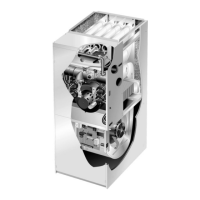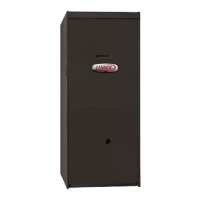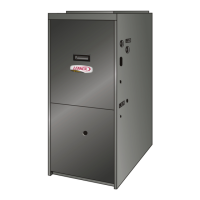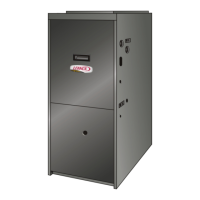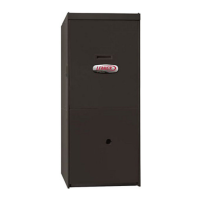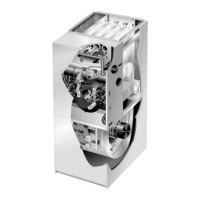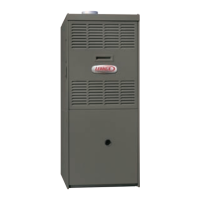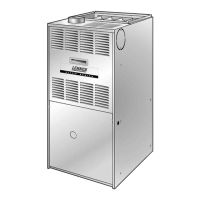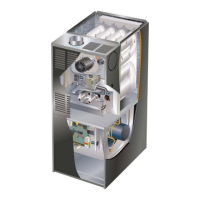Page 32
When checking piping connections for gas leaks, use pre-
ferred means. Kitchen detergents can cause harmful corro-
sion on various metals used in gas piping. Use of a specialty
Gas Leak Detector is strongly recommended. It is available
through Lennox under part number 31B2001. See Corp.
8411−L10, for further details.
Do not use matches, candles, flame or any other source of
ignition to check for gas leaks.
D−Testing Gas Supply Pressure
When testing supply gas pressure, connect test gauge to
inlet pressure tap on the gas valve. See figures and 35 and
36. Check gas line pressure with unit firing at maximum
rate. Low pressure may result in erratic operation or under-
fire. High pressure can result in permanent damage to gas
valve or overfire. See table 15 for operating pressure at unit
gas connection (line).
On multiple unit installations, each unit should be checked
separately, with and without units operating. Supply pres-
sure must fall within range listed in table 15.
TABLE 15
All G61MP Units Natural LP
Line Pressure WC" 4.5 − 10.5 11.0 − 13.0
E−Check Manifold Pressure
After line pressure has been checked and adjusted, check
manifold pressure. Move pressure gauge to outlet pres-
sure tap located on unit gas valve (GV1). Checks of man-
ifold pressure are made as verification of proper regulator ad-
justment. Manifold pressure for the G61MP can be measured
at any time the gas valve is open and is supplying gas to the
unit. See table 19 for manifold pressures.
IMPORTANT
For safety, connect a shut-off valve between the
manometer and the gas tap to permit shut off of
gas pressure to the manometer.
The gas valve is factory set and should not require adjust-
ment. All gas valves are factory regulated sensing atmo-
spheric pressure.
Manifold Pressure Measurement & Adjustment
NOTE − Pressure test adapter kit (10L34) is available from
Lennox to facilitate manifold pressure measurement.
1 − Connect test gauge to outlet tap on gas valve.
2 − Disconnect pressure sensing hose from gas valve.
3 − Start unit on low heat and allow 5 minutes for unit to
reach steady state.
4 − While waiting for the unit to stabilize, notice the flame.
Flame should be stable and should not lift from burner.
Natural gas should burn blue.
5 − After allowing unit to stabilize for 5 minutes, record
manifold pressure and compare to value given in table
19.
6 − Repeat steps 3, 4 and 5 on high heat.
NOTE − Shut unit off and remove manometer as soon as an
accurate reading has been obtained. Take care to replace
pressure tap plug.
NOTE − During this test procedure, the unit will be overfir-
ing:
D Operate unit only long enough to obtain accurate read-
ing to prevent overheating heat exchanger.
D Attempts to clock gas meter during this procedure will
be inaccurate. Measure gas flow rate only during nor-
mal unit operation.
7 − When test is complete remove obstruction from hose
and return hose to gas valve barbed fitting.
F− Proper Gas Flow (Approximate)
Furnace should operate at least 5 minutes before check-
ing gas flow. Determine time in seconds for two revolu-
tions of gas through the meter. (Two revolutions assures a
more accurate time.) Divide by two and compare to time
in table 16 below. If manifold pressure matches table 15
and rate is incorrect, check gas orifices for proper size and
restriction.
NOTE− To obtain accurate reading, shut off all other gas
appliances connected to meter.
TABLE 16
GAS METER CLOCKING CHART
Seconds for One Revolution
G61MP
Natural LP
Unit
1 cu ft
Dial
2 cu ft
Dial
1 cu ft
Dial
2 cu ft
DIAL
−45 82 164 205 410
−70 55 110 136 272
−90 41 82 102 204
−110 33 66 82 164
−135 27 54 68 136
Natural−1000 btu/cu ft LP−2500 btu/cu ft
IMPORTANT
For safety, shut unit off and remove manometer as
soon as an accurate reading has been obtained.
Take care to replace pressure tap plug.
G− Proper Combustion
Furnace should operate minimum 15 minutes with correct
manifold pressure and gas flow rate before checking com-
bustion. See sections E− and F−. Take combustion sample
beyond the flue outlet and compare to the tables below.
The maximum carbon monoxide reading should not ex-
ceed 100 ppm.
